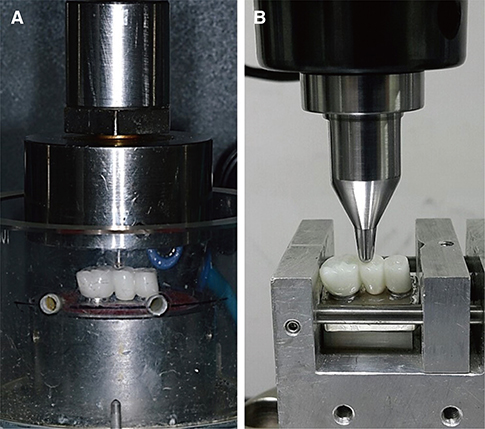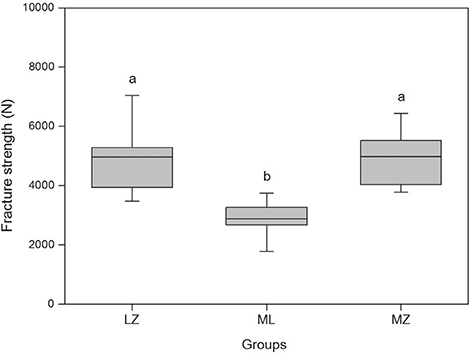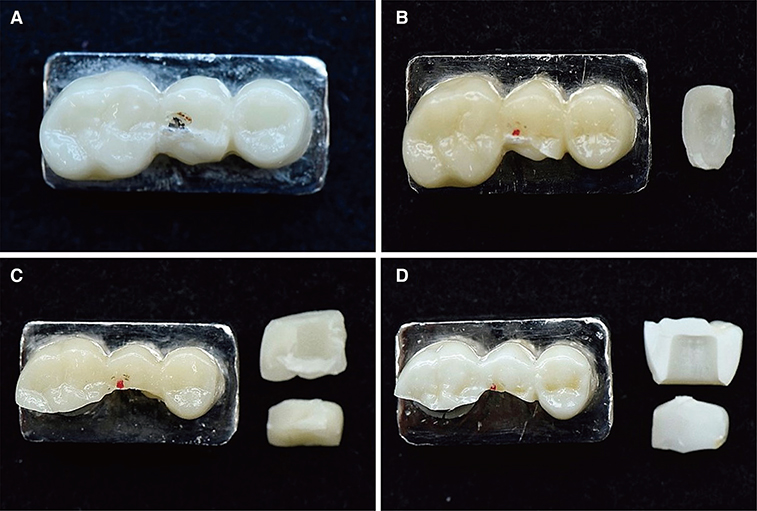J Adv Prosthodont.
2017 Aug;9(4):244-251. 10.4047/jap.2017.9.4.244.
In vitro study of the fracture resistance of monolithic lithium disilicate, monolithic zirconia, and lithium disilicate pressed on zirconia for three-unit fixed dental prostheses
- Affiliations
-
- 1Department of Prosthodontics, Dental Research Institute, Institute of Translation Dental Science, School of Dentistry, Pusan National University, Yangsan, Republic of Korea. huhjb@pusan.ac.kr
- 2BK21 PLUS Project, School of Dentistry, Pusan National University, Yangsan, Republic of Korea.
- 3Department of Prosthodontics, Pusan National University Hospital, Pusan, Republic of Korea.
- KMID: 2398070
- DOI: http://doi.org/10.4047/jap.2017.9.4.244
Abstract
- PURPOSE
The purpose of this study was to determine fracture resistance and failure modes of three-unit fixed dental prostheses (FDPs) made of lithium disilicate pressed on zirconia (LZ), monolithic lithium disilicate (ML), and monolithic zirconia (MZ).
MATERIALS AND METHODS
Co-Cr alloy three-unit metal FDPs model with maxillary first premolar and first molar abutments was fabricated. Three different FDPs groups, LZ, ML, and MZ, were prepared (n = 5 per group). The three-unit FDPs designs were identical for all specimens and cemented with resin cement on the prepared metal model. The region of pontic in FDPs was given 50,000 times of cyclic preloading at 2 Hz via dental chewing simulator and received a static load until fracture with universal testing machine fixed at 10°. The fracture resistance and mode of failure were recorded. Statistical analyses were performed using the Kruskal-Wallis test and Mann-Whitney U test with Bonferroni's correction (α=0.05/3=0.017).
RESULTS
A significant difference in fracture resistance was found between LZ (4943.87 ± 1243.70 N) and ML (2872.61 ± 658.78 N) groups, as well as between ML and MZ (4948.02 ± 974.51 N) groups (P<.05), but no significant difference was found between LZ and MZ groups (P>.05). With regard to fracture pattern, there were three cases of veneer chipping and two interfacial fractures in LZ group, and complete fracture was observed in all the specimens of ML and MZ groups.
CONCLUSION
Compared to monolithic lithium disilicate FDPs, monolithic zirconia FDPs and lithium disilicate glass ceramics pressed on zirconia-based FDPs showed superior fracture resistance while they manifested comparable fracture resistances.
Keyword
MeSH Terms
Figure
Cited by 1 articles
-
Effects of different finishing/polishing protocols and systems for monolithic zirconia on surface topography, phase transformation, and biofilm formation
Hang-Nga Mai, Su-Hyung Hong, Sung-Hun Kim, Du-Hyeong Lee
J Adv Prosthodont. 2019;11(2):81-87. doi: 10.4047/jap.2019.11.2.81.
Reference
-
1. Lüthy H, Filser F, Loeffel O, Schumacher M, Gauckler LJ, Hammerle CH. Strength and reliability of four-unit all-ceramic posterior bridges. Dent Mater. 2005; 21:930–937.2. Datla SR, Alla RK, Alluri VR, Babu JP, Konakanchi A. Dental ceramics: Part II - Recent advances in dental ceramics. Am J Mater Eng Technol. 2015; 3:19–26.3. Venclíkova Z, Benada O, Bártova J, Joska L, Mrklas L. Metallic pigmentation of human teeth and gingiva: morphological and immunological aspects. Dent Mater J. 2007; 26:96–104.4. Donovan TE. Factors essential for successful all-ceramic restorations. J Am Dent Assoc. 2008; 139:14S–18S.5. Sailer I, Fehér A, Filser F, Gauckler LJ, Lüthy H, Hämmerle CH. Five-year clinical results of zirconia frameworks for posterior fixed partial dentures. Int J Prosthodont. 2007; 20:383–388.6. Schultheis S, Strub JR, Gerds TA, Guess PC. Monolithic and bi-layer CAD/CAM lithium-disilicate versus metal-ceramic fixed dental prostheses: comparison of fracture loads and failure modes after fatigue. Clin Oral Investig. 2013; 17:1407–1413.7. Rekow ED, Silva NR, Coelho PG, Zhang Y, Guess P, Thompson VP. Performance of dental ceramics: challenges for improvements. J Dent Res. 2011; 90:937–952.8. Kim HK, Kim SH. Effect of the number of coloring liquid applications on the optical properties of monolithic zirconia. Dent Mater. 2014; 30:e229–e237.9. Takeichi T, Katsoulis J, Blatz MB. Clinical outcome of single porcelain-fused-to-zirconium dioxide crowns: a systematic review. J Prosthet Dent. 2013; 110:455–461.10. Sailer I, Gottnerb J, Kanelb S, Hammerle CH. Randomized controlled clinical trial of zirconia-ceramic and metal-ceramic posterior fixed dental prostheses: a 3-year follow-up. Int J Prosthodont. 2009; 22:553–560.11. Silva NR, Bonfante EA, Rafferty BT, Zavanelli RA, Rekow ED, Thompson VP, Coelho PG. Modified Y-TZP core design improves all-ceramic crown reliability. J Dent Res. 2011; 90:104–108.12. Baltzer A. All-ceramic single-tooth restorations: choosing the material to match the preparation-preparing the tooth to match the material. Int J Comput Dent. 2008; 11:241–256.13. Schmitter M, Schweiger M, Mueller D, Rues S. Effect on in vitro fracture resistance of the technique used to attach lithium disilicate ceramic veneer to zirconia frameworks. Dent Mater. 2014; 30:122–130.14. Kim SY, Choi JW, Ju SW, Ahn JS, Yoon MJ, Huh JB. Fracture strength after fatigue loading of lithium disilicate pressed zirconia crowns. Int J Prosthodont. 2016; 29:369–371.15. Guess PC, Zhang Y, Thompson VP. Effect of veneering techniques on damage and reliability of Y-TZP trilayers. Eur J Esthet Dent. 2009; 4:262–276.16. Ambre MJ, Aschan F, Vult von Steyern P. Fracture strength of yttria-stabilized zirconium-dioxide (Y-TZP) fixed dental prostheses (FPDs) with different abutment core thicknesses and connector dimensions. J Prosthodont. 2013; 22:377–382.17. Wimmer T, Erdelt KJ, Eichberger M, Roos M, Edelhoff D, Stawarczyk B. Influence of abutment model materials on the fracture loads of three-unit fixed dental prostheses. Dent Mater J. 2014; 33:717–724.18. Nawafleh N, Hatamleh M, Elshiyab S, Mack F. Lithium disilicate restorations fatigue testing parameters: A systematic review. J Prosthodont. 2016; 25:116–126.19. Kelly JR. Clinically relevant approach to failure testing of all-ceramic restorations. J Prosthet Dent. 1999; 81:652–661.20. Wiskott HW, Nicholls JI, Belser UC. Stress fatigue: basic principles and prosthodontic implications. Int J Prosthodont. 1995; 8:105–116.21. Zhang L, Wang Z, Chen J, Zhou W, Zhang S. Probabilistic fatigue analysis of all-ceramic crowns based on the finite element method. J Biomech. 2010; 43:2321–2326.22. Beuer F, Steff B, Naumann M, Sorensen JA. Load-bearing capacity of all-ceramic three-unit fixed partial dentures with different computer-aided design (CAD)/computer-aided manufacturing (CAM) fabricated framework materials. Eur J Oral Sci. 2008; 116:381–386.23. McLaren EA, Giordano RA. Zirconia-based ceramics: Material properties, esthetics, and layering techniques of a new veneering porcelain, VM9. Quintessence Dent Technol. 2005; 28:99–112.24. Preis V, Weiser F, Handel G, Rosentritt M. Wear performance of monolithic dental ceramics with different surface treatments. Quintessence Int. 2013; 44:393–405.25. DeLong R. Intra-oral restorative materials wear: rethinking the current approaches: how to measure wear. Dent Mater. 2006; 22:702–711.26. Woda A, Mishellany A, Peyron MA. The regulation of masticatory function and food bolus formation. J Oral Rehabil. 2006; 33:840–849.27. Rees JS. An investigation into the importance of the periodontal ligament and alveolar bone as supporting structures in finite element studies. J Oral Rehabil. 2001; 28:425–432.28. Cho L, Song H, Koak J, Heo S. Marginal accuracy and fracture strength of ceromer/fiber-reinforced composite crowns: effect of variations in preparation design. J Prosthet Dent. 2002; 88:388–395.29. Rosentritt M, Naumann M, Hahnel S, Handel G, Reill M. Evaluation of tooth analogs and type of restoration on the fracture resistance of post and core restored incisors. J Biomed Mater Res B Appl Biomater. 2009; 91:272–276.30. Tinschert J, Natt G, Mautsch W, Augthun M, Spiekermann H. Fracture resistance of lithium disilicate-, alumina-, and zirconia-based three-unit fixed partial dentures: a laboratory study. Int J Prosthodont. 2001; 14:231–238.31. Scherrer SS, de Rijk WG. The fracture resistance of all-ceramic crowns on supporting structures with different elastic moduli. Int J Prosthodont. 1993; 6:462–467.32. Potiket N, Chiche G, Finger IM. In vitro fracture strength of teeth restored with different all-ceramic crown systems. J Prosthet Dent. 2004; 92:491–495.33. Bindl A, Lüthy H, Mörmann WH. Strength and fracture pattern of monolithic CAD/CAM-generated posterior crowns. Dent Mater. 2006; 22:29–36.34. Rosentritt M, Behr M, Gebhard R, Handel G. Influence of stress simulation parameters on the fracture strength of all-ceramic fixed-partial dentures. Dent Mater. 2006; 22:176–182.35. Sorensen JA, Choi C, Fanuscu MI, Mito WT. IPS Empress crown system: three-year clinical trial results. J Calif Dent Assoc. 1998; 26:130–136.36. Clausen JO, Abou Tara M, Kern M. Dynamic fatigue and fracture resistance of non-retentive all-ceramic full-coverage molar restorations. Influence of ceramic material and preparation design. Dent Mater. 2010; 26:533–538.37. Della Bona A, Mecholsky JJ Jr, Anusavice KJ. Fracture behavior of lithia disilicate- and leucite-based ceramics. Dent Mater. 2004; 20:956–962.38. Apel E, Deubener J, Bernard A, Höland M, Müller R, Kappert H, Rheinberger V, Höland W. Phenomena and mechanisms of crack propagation in glass-ceramics. J Mech Behav Biomed Mater. 2008; 1:313–325.39. Rodríguez V, Castillo-Oyagüe R, López-Suárez C, Gonzalo E, Peláez J, Suárez-García MJ. Fracture load before and after veneering zirconia posterior fixed dental prostheses. J Prosthodont. 2016; 25:550–556.40. Garvie RC, Hannink RH, Passcoe RT. Ceramic Steel? Nature. 1975; 258:703–704.41. Luthardt RG, Sandkuhl O, Reitz B. Zirconia-TZP and alumina-advanced technologies for the manufacturing of single crowns. Eur J Prosthodont Restor Dent. 1999; 7:113–119.42. Weyhrauch M, Igiel C, Scheller H, Weibrich G, Lehmann KM. Fracture strength of monolithic all-ceramic crowns on titanium implant abutments. Int J Oral Maxillofac Implants. 2016; 31:304–309.43. Belli R, Petschelt A, Hofner B, Hajtó J, Scherrer SS, Lohbauer U. Fracture rates and lifetime estimations of CAD/CAM all-ceramic restorations. J Dent Res. 2016; 95:67–73.44. Guess PC, Zavanelli RA, Silva NR, Bonfante EA, Coelho PG, Thompson VP. Monolithic CAD/CAM lithium disilicate versus veneered Y-TZP crowns: comparison of failure modes and reliability after fatigue. Int J Prosthodont. 2010; 23:434–442.
- Full Text Links
- Actions
-
Cited
- CITED
-
- Close
- Share
- Similar articles
-
- Clinical Evaluation of Lithium Disilicate Pressed Zirconia and Monolithic Zirconia in Posterior Implant-Supported Prostheses
- A prospective clinical of lithium disilicate pressed zirconia and monolithic zirconia in posterior implant-supported prostheses: A 24-month follow-up
- Properties of translucent zirconia and lithium disilicate glass-ceramics: a literature review
- Comparative analysis of transmittance for different types of commercially available zirconia and lithium disilicate materials
- Fracture resistance of implant- supported monolithic crowns cemented to zirconia hybrid-abutments: zirconia-based crowns vs. lithium disilicate crowns








